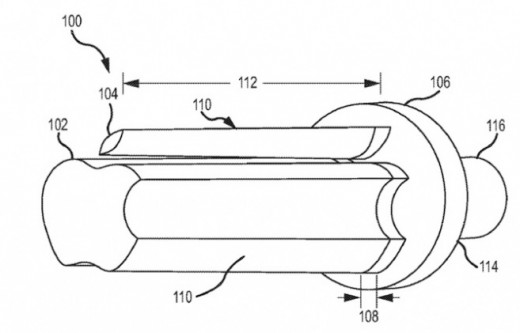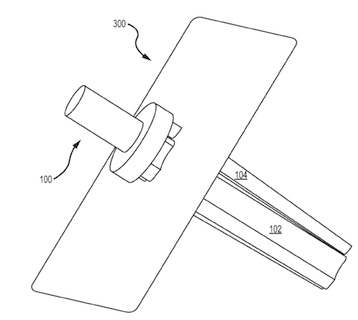Diese Frage scheint nun weitgehend geklärt, denn ein Patent
The cutting apparatus includes a base member and an elongate member extending from the base member. The elongate member includes a tapered region having an abrasive surface. The tapered region defines at least one vertex defining an angle of a desired cutout shape. Additionally, the tapered region is toothless.
Zuerst wird, wie zu erwarten, eine der Grundform ähnliche geometrische Form mittels CNC ausgeschnitten – im Fall des Apfels ein Kreis oder Oval. Schließlich wird mithilfe einer Art speziellen Feile in Form des Apfels dieses Loch beständig vergrößert. Der mit einem Schleifmaterial bedeckte Logo-Zylinder ist an der Spitze so klein, dass er ins vorgefertigte Loch passt, und wird zur Basis hin immer größer – so kann der Apfel bis zur endgültigen Größe ausgeschliffen werden.
Warum sollte Apple aber seine eigene Technologie entwerfen, wenn man z.B. Metall ganz einfach stanzen könnte? Die Antwort liegt im Detail: Herkömmliche Techniken wie CNC-Fräsen oder Wasser- bzw. Laser-Cutting erreichen ohne intensiven Kostenaufwand nicht die gewünschten feinen, scharfen Details. Die entstehenden „rauhen Ränder mit herausragenden Fasern“ erzeugen ein „nicht akzeptables Aussehen“.
“When the ultimately desired shape is an apple, the general shape created by CNC milling may be a circle or oval. Often, the aperture may be a circle, a square or other geometric shape”. Apple describes a manufacturing process in intricate detail. “A tapered shaft having an abrasive surface is inserted into the aperture. The cross-section of the shaft is the shape of the desired intricate cut. The shaft gradually expands radially (i.e., gets bigger) along the length of the shaft. As the shaft increases in size, the cross-section shape stays the same. That is, the shape of the shaft remains the same along the length of the shaft as the cross-sectional size of the shaft increases due to the taper. The tapered shaft is toothless. That is, the tapered region does not include teeth, in contrast to conventional broach tools, for cutting through material,” the patent explains.

